Throughout history, humans have selectively bred horses, resulting in a diverse range of breeds, each with its own purpose and characteristics. Some of these breeds have gained fame for their enormous size, captivating us with their majestic appearance and incredible strength.
Originally bred for farm work, pulling carts, and carrying heavy loads, these large horse breeds quickly became indispensable assets due to their exceptional work ethic and calm nature.
In this post, we’ll explore the world’s largest horse breeds, their unique traits and interesting facts that set apart from other horse breeds.
But before we list off these giant horse breeds let’s talk about the biggest horses on record, for heaviest horse and tallest horse.

Who was the heaviest horse there ever was?
If you’re searching for the record of the heaviest horse ever, you’ll come across the name Sampson, who was also known as Mammoth. This impressive horse was a member of the Shire breed.
Shire horses are known for their large size, but even among these, Sampson stood out as a giant.
Born in the year 1846 in Bedfordshire, England, Sampson grew to weigh an unbelievable 3,360 pounds, or 1,524 kilograms.
That’s more than the weight of most small cars! It’s also almost twice the size of an average horse. He was given the name Mammoth when he was four years old because of his large size.
Sampson’s record still stands today, and his name is often mentioned in talks about the biggest animals in the world.
His story continues to capture the interest of people who love horses and those who simply find giant animals impressive.
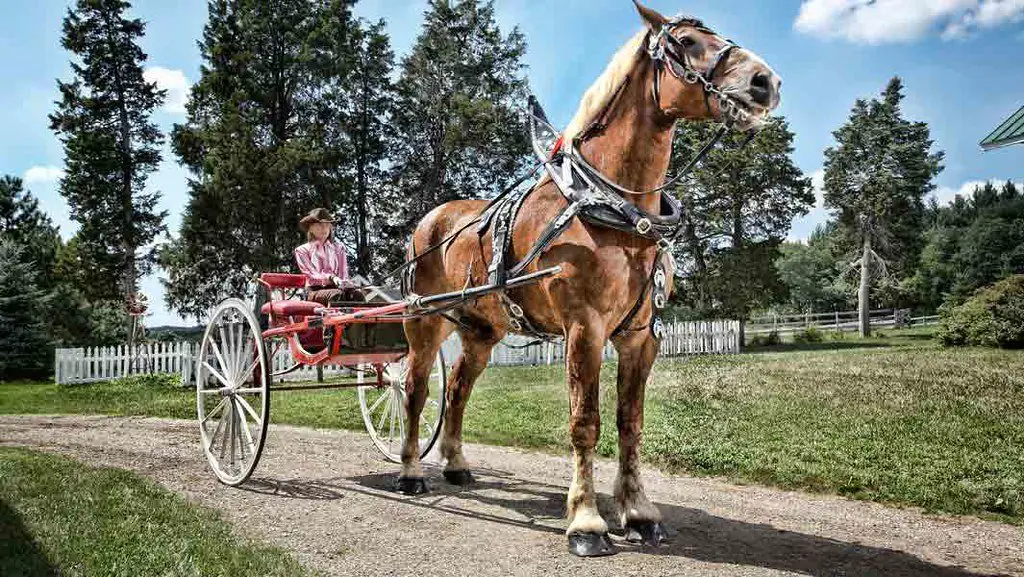
Who was the tallest horse there ever was?
When it comes to the tallest horse ever, Big Jake is the star. This Belgian horse still trots the Earth today, boasting a height that is greater than any other horse in history.
Big Jake stands over 22 hands tall, beating the record of all other horses, including Sampson.
Despite not being as heavy as Sampson, Big Jake still weighs a solid 2,260 pounds. That’s still a lot when compared to the average horse.
Because of his massive size, his owners have to carefully manage his diet. This is crucial in order to keep his joints healthy. Overeating could lead to excess weight, which might put too much strain on his joints.
So, if you are interested in the tallest horse in the world, Big Jake is the name to remember. His title as the tallest horse remains unbroken, just like Sampson’s record for the heaviest horse.
Quick Look At The Biggest Horse Breeds
In the diverse world of horse breeds, several stand out due to their towering heights and impressive weights.
These horse breeds are cherished for their power and endurance, essential for heavy work, such as pulling heavy loads or plowing fields.
The following list presents these breeds along with their average height and weight.
- Shire Horse: Renowned for their great size, Shire horses stand 16 to 17.2 hands high, roughly 68 inches, and weigh between 1,870 to 2,430 pounds.
- Belgian Horse: Averaging at about 16.2 to 17 hands in height, which translates to about 64-67 inches, and weighing in at about 1800-2,000 pounds, Belgian horses are hardy and strong.
- Clydesdale Horse: Clydesdales, known for their distinctive feathering around their lower legs, measure 16 to 18 hands tall, approximately 68 inches, and weigh between 1,800 to 2,000 pounds.
- Percheron Horse: These versatile horses are 16.2 to 17.3 hands high, about 68 inches, and weigh between 1,800 to 2,200 pounds.
- Suffolk Punch Horse: Suffolk Punches, characterized by their chestnut color, stand at about 16.1 to 17.2 hands tall and weigh between 1,600 to 2,000 pounds.
- Australian Draught: Native to Australia, these horses measure around 16.2 to 17.2 hands high, or 68 inches, and weigh between 1,300 to 1,900 pounds.
- Dutch Draft Horse: Known for their calm temperament, Dutch Draft horses are about 15 to 17 hands high and weigh around 1,550 to 1,650 pounds.
- American Cream Draft: These are the only draft breed developed in the United States and stand at about 15.1 to 16.3 hands high, or 62 inches, and weigh between 1,600 to 1,800 pounds.
- Boulonnais Horse: Originating from France, Boulonnais horses stand at about 15.1 to 17 hands high, approximately 64 inches, and weigh between 1,430 to 1,650 pounds.
- Ardennes: Originating from the Ardennes area in Belgium, France, and Luxembourg, these horses are known for their strength and resilience. They usually stand about 15 to 16 hands high and have a hefty weight range between 1,650 to 2,200 pounds.
- Russian Heavy Draft: A robust horse breed known for its draft work capabilities, considerable milk yield, and meat, with average weights of stallions ranging from 1,200 – 1,550 pounds and standing 14.1 – 15 hands tall, and a lifespan of around 25-31 years.
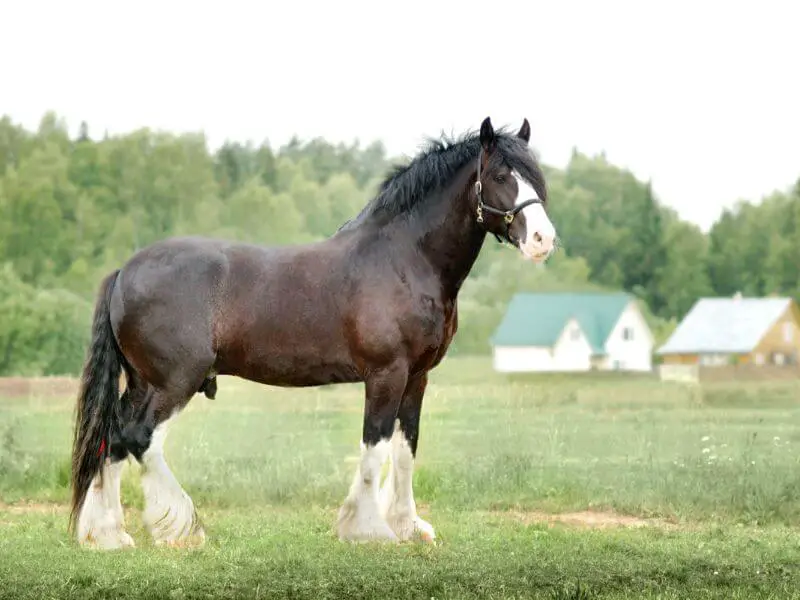
#1 Biggest Horse Breed: Shire
Origin: England
Size: Typically ranges from 17 to 19 hands tall.
Weight: Usually weighs between 1,800 and 2,400 pounds.
Uses: Historically used for heavy-duty farm work, forestry, and industrial tasks. Currently popular for show, pleasure-riding, and sustainable farming methods.
Shire horses, born in England, are the world’s biggest horse breed. They’re like real-life giants! But they’re not just big – they’re also strong, kind, and gentle.
These horses have a special look. They’re usually black, brown, gray, or bay, but sometimes they’re chestnut too.
One cool thing about Shire horses is the fluffy hair, called feathering, around their legs. A small white mark on the face or leg is okay, but too much white isn’t preferred.
Shire horses come from a long line of brave “great horses” used by English knights in battles. Over time, these knights’ horses were bred with Dutch horses to create the Shire breed we see today.
These large horses were the perfect workers back in the day. They carried heavy carts on farms, moved big equipment, and even pulled huge barrels of beer from breweries.
One Shire horse, named Vulcan, was known for pulling a load that weighed as much as 29 small cars! But even with their size and strength, Shire horses are known for their calm and friendly nature.
Sadly, as people started to rely more on technology during World War II, the number of Shire horses began to decline.
Don’t worry though, Shire horses have been actively sought for by their admirers. These horses are now mostly utilized for joyrides, shows, and even for forest labor. They are regaining popularity on small farms since they are a green option.
The biggest and heaviest of them all was a Shire horse by the name of Sampson. He weighed as much as a small car and was as tall as a small elephant!

#2 Biggest Horse Breed: Belgian
Origin: Belgium
Height: 16.1 to 18 hands (some individuals, like Brooklyn Supreme, have been known to stand 19 hands tall)
Weight: Typically 1,800 to 2,200 pounds (exceptionally large individuals can weigh more than 3,000 pounds)
Temperament: Known for their calm dispositions, gentle natures, and bonding closely with their handlers.
The Belgian Draft horse, often just called a “Belgian,” is a really big and strong horse that comes from Belgium. These horses are among the biggest in the world.
They were first called “Flanders Horses,” and they come from the same family as the Brabant horse. After World War II, though, they became their own breed.
A Belgian horse is usually between 16.1 and 18 hands high, which is the way we measure horses from the ground to their shoulders. That means they can be as tall as 6 feet!
They also weigh a lot, between 1,800 and 2,200 pounds. However, some of the biggest Belgian horses, like Brooklyn Supreme, have been even bigger. He was 19 hands high and weighed more than 3,000 pounds.
Belgian horses are extremely strong. They can actually pull loads weighing more than 17,000 pounds. That is equivalent to two compact automobiles!
They are therefore frequently employed in forestry, farming, and pulling competitions. But don’t be fooled by their appearance. Belgian horses are renowned for being incredibly sociable and docile.
These horses are extremely powerful, but they are also susceptible to a condition known as equine polysaccharide storage myopathy (PSSM). Their muscles may become weak as a result, making movement difficult.
American-born Belgian horses are typically lighter than their counterparts back home. Additionally, they are available in a variety of hues, such as bay, chestnut, sorrel, and roan. But chestnut with a white mane and tail is the hue that people most often choose.
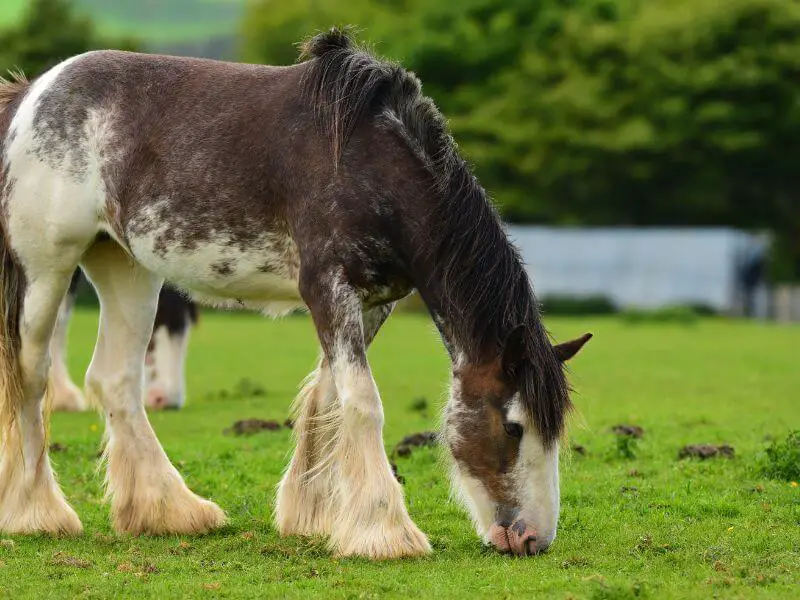
#3 Biggest Horse Breed: Clydesdale
Origin: Scotland
Average Height: 16 to 18 hands (64 to 72 inches)
Average Weight: 1,800 to 2,000 pounds (820 to 910 kg)
Notable Traits: High trainability, gentle yet energetic nature, distinctive high-stepping gait, and feathery legs.
Clydesdale horses, native to Scotland, are some of the largest horse breeds in the world. You might recognize them from Budweiser commercials or see them in parades.
They’re known for their tall size, which can reach up to 18 hands (a hand is about four inches), and for their weight, often reaching 2,000 pounds or more.
They stand out with their unique high-stepping walk and the fluffy hair, or feathers, around their hooves.
These features, along with their calm personalities and smarts, make them well-loved and easy to train.
Some horses, like King LeGear, have even grown beyond the average size. He stood a whopping 20.5 hands tall and weighed 2,950 pounds, earning him a spot in the list of the biggest horses in history.
Besides their impressive size, Clydesdales also have a range of coat colors. They can be bay, black, chestnut, grey, or Sabino, with white markings commonly found on their faces, feet, and legs. The white feathers on their legs need daily grooming to keep them healthy and looking good.
Clydesdales aren’t just for show; they’re hard workers too. They’ve been used in agriculture, forestry, and other areas that need heavy lifting. Despite their large size, they’re also used for riding, although it can be a bit of a challenge to get on them due to their height.
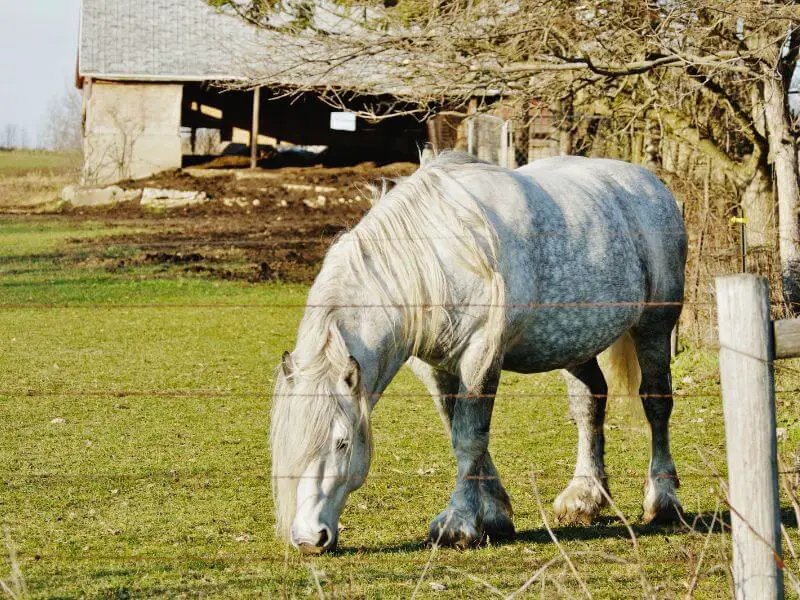
#4 Biggest Horse Breed: Percheron
Origin: Perche province, France’s Normandy region
Average Height: 15 to 19 hands (with some exceptions reaching 21 hands)
Average Weight: 1,800 to 2,600 pounds
Common Colors: Most commonly gray or black, depending on the country of breeding
Some of the largest horse breeds in the world are Percheron horses, which have their origins in France. In the Normandy region, these sturdy and robust horses were first bred for farm work. They are now admired all around the world for their size, power, and beauty.
The relationship between Percherons and Arabian horses is an intriguing fact. Breeders began fusing Percherons and Arabian horses in the 1800s. Percherons didn’t get weaker or smaller as a result of this.
They instead had an elegant appearance with a fine head and slim neck as a result.
A Percheron’s size can vary according on the area where it was bred. They often weigh between 1,800 and 2,600 pounds and stand between 15 and 19 hands tall.
Though there are few outliers. A Percheron named Dr. LeGear, for instance, stood 21 hands high and weighed 2,995 pounds.
Most Percherons have a dark or light coat of fur. In the United States, though, you’ll discover a wide variety of coat colors among Percherons. The affable character of Percherons, in addition to their stature, is what sets them apart. They get along well with other horses and people, have a high level of intelligence, and are simple to train.
Although they are large and powerful, Percheron horses still possess an air of elegance. The fluidity and grace with which they move make them a crowd favorite at performances and parades.
When crossbred with smaller, lighter horses, they find usage in dressage competitions.
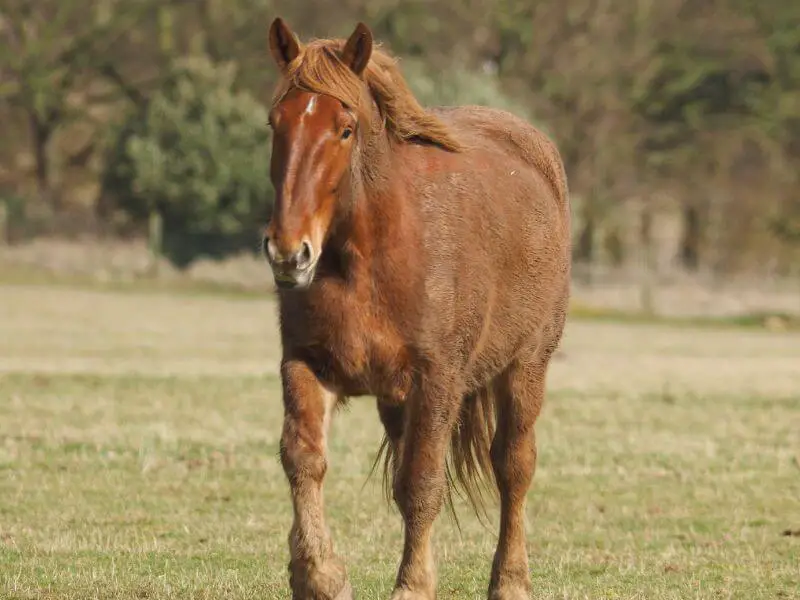
#5 Biggest Horse Breed: Suffolk Punch
Origin: Suffolk and Norfolk, England. This breed has a history dating back to the 1500s.
Height: The Suffolk Punch stands between 16.1 and 17.2 hands tall.
Weight: Typically, these horses weigh from 1,900 to 2,200 pounds.
Color: The Suffolk Punch horse is always chestnut in color, with variations including dark liver, dull dark, red, and bright. It’s unusual to find one with white markings.
The Suffolk Punch, a horse breed from England, has a long history and unique appearance. These horses were first bred in the English counties of Suffolk and Norfolk, mainly for farm work.
The breed is named after the puppet character ‘Punch’ from the old ‘Punch-and-Judy’ puppet shows because of their round and sturdy body.
All Suffolk Punch horses are descendants of one horse named Crisp’s Horse of Ufford, born in 1768.
Over the centuries, the breed hasn’t changed much. Today, these horses are rare, and their status is ‘Critical’ on the American Livestock Breeds Conservatory list.
Suffolk Punch horses stand out with their chestnut color coat that can range from dark liver, dull dark, red, to bright shades. No two horses look the same.
They are one of the biggest horse breeds, standing 16.1 to 17.2 hands tall and weighing between 1,900 to 2,200 pounds. They also have powerful rear legs, making them excellent workers, especially in farming and forestry.
People love Suffolk Punch horses for their kind nature and willingness to work. They are easy to take care of and can handle different climates, which makes them suitable for various tasks beyond their farming roots.
Despite being bred specifically for farm work, these horses have become popular for advertising because of their impressive size and beautiful appearance.
But the number of Suffolk Punch horses is dropping. Since the late 1940s, fewer of these horses exist, partly because of the World Wars. There’s a real need to protect this breed and keep it from disappearing.
#6 Biggest Horse Breed: Australian Draft
Height: On average, the Australian Draught stands between 16 and 17.2 hands tall.
Weight: Typically, these horses weigh between 1,300 and 1,980 pounds.
Life Expectancy: The Australian Draught horse has a life expectancy of 20 to 30 years.
Country of Origin: The breed was developed in Australia in the mid-19th century.
The Australian Draught horse is a large and strong breed that farmers in Australia started raising around 1850. They needed a work animal faster than the bullocks they were using for farming.
These horses came from a mix of other big breeds like the Clydesdale, Percheron, Shire, and Suffolk Punch. Even more recently, they’ve also been bred with the Belgian Draft.
This mixing of breeds has resulted in a variety of colors for the Australian Draught, including white, black, gray, roan, and brown.
These horses are pretty big, usually standing 16 to 17.2 hands tall and weighing between 1,300 and 1,980 pounds. But despite their size, they’re known for being easy to handle and really tough, making them great for both farm work and riding.
It’s fascinating to note that these horses didn’t gain official breed status until 1976. No one ever thought to begin registering them until 1978. These days, many horses that seem like classic examples of the Australian Draught breed aren’t actually registered as such.
These characteristics include bright eyes, a neck of average length, robust shoulders, a broad chest, muscular hips, and sturdy thighs. Feathering, which refers to lengthy, hairlike fur, is also present on their legs.
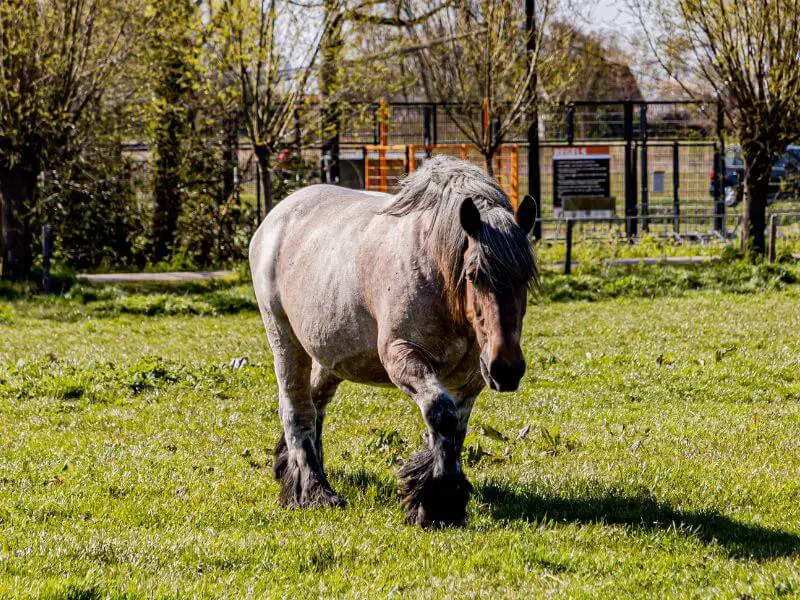
#7 Biggest Horse Breed: Dutch Draft
Origin: The Netherlands
Height: 15 to 17 hands (approximately 60 to 68 inches)
Weight: 1,500 to 1,800 pounds
Common Colors: Bay, grey, chestnut, and sometimes black
The Dutch Draft horse, bred in the Netherlands, is one of the biggest horse breeds in the world. Born from a mix of Ardennes and Belgian Draft horses after World War I, it’s an animal that is both strong and gentle. Its large size and chunky body shape, along with its wide neck and short legs, make it truly unique.
Typically, these horses are about 62 inches tall (or 15 to 17 hands in horse terms), and they can weigh anywhere from 1,500 to 1,800 pounds.
That’s heavier than most other horse breeds! Despite their size, they are shorter than other draft horses.
This doesn’t take away from their strength though; in fact, Dutch Draft horses are known for being able to pull heavy loads for long periods.
Dutch Draft horses can be different colors. Some are bay, which is a reddish-brown color, while others are grey, chestnut, or even black. This variety adds to their appeal. These horses also have unique feathered hooves which are quite a sight!
In the past, farmers and other heavy laborers frequently relied on Dutch Draft horses.
However, their numbers drastically decreased as a result of the consequences of World War II and the shifts in farming practices that followed. They are now an endangered species, but are gaining in popularity anyway.
The kind and sociable reputation of Dutch Draft horses has contributed to their popularity. They are intelligent and simple to teach, making them ideal for inexperienced riders. They are large and powerful, but surprisingly kind.
#8 Biggest Horse Breed: American Cream Draft
Height: 15.1 to 16.3 hands tall
Weight: The weight range of these horses is usually between 1,600 to 2,000 pounds.
Color: All American Cream Draft horses sport a unique cream or palomino color, officially known as gold champagne.
Population: The American Cream Draft is considered the world’s rarest draft horse breed, with a total of only 400 horses currently registered.
Let’s go on a trip back in time to the 1850s in Iowa. Here, a special horse named Old Granny was sold at auction. Old Granny wasn’t just any horse; she was the first of her kind.
She was an American Cream Draft horse, a breed that’s all-American, and completely unique.
American Cream Draft horses are big and strong. They can stand 62 inches tall and weigh up to 2,000 pounds. But their size isn’t what makes them special. It’s their color.
They have a solid cream or light brown color, which is where they get their name.
The American Cream Draft started with Old Granny in 1911. Today, almost all American Creams can trace their family tree back to her.
These horses are known for their strength, their wide chests, and their strong backs. They’re great at hard work like pulling carriages, performing in shows, and even dressage, a type of horse dancing.
But the American Cream Draft is very rare. In fact, it’s the rarest draft horse breed in the world with only 400 registered. Even though they’re popular in the U.S, they are considered a critical breed because there are so few of them. This means we need to work hard to keep this breed alive.
The good news is that more of these horses are being registered each year, showing hope for the future.
So if you ever see an American Cream Draft, you’re looking at a rare piece of American history. These horses are big, beautiful, and unique, just like the country they come from.
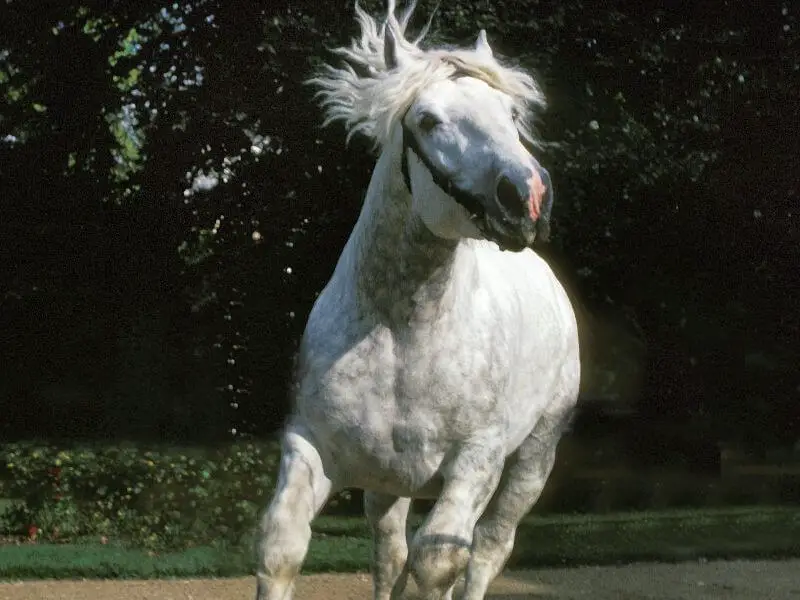
#9 Biggest Horse Breed: Boulonnais
Country of Origin: France
Height: Typically 15.1 – 17 hands (can range from 14.3 – 17 hands)
Weight: Generally between 1,250 – 1,650 pounds
Life Expectancy: 20 – 25 years
The Boulonnais is an amazing horse breed from France, often called the “White Marble Horse.” It’s big and strong, but also really friendly. These horses are usually around 15.1 to 17 hands high, which is a fancy way of saying they’re about 64 inches tall. They can weigh anywhere between 1,250 and 1,650 pounds. That’s about as heavy as a small car!
This breed has a cool history. Some people think it started with horses from Julius Caesar’s army! Later, they mixed Boulonnais with other breeds like Arabian and Spanish horses.
This helped make the Boulonnais we know today.
The Boulonnais horse is a diverse breed. The smaller ones used to drive fish carts from Boulogne to Paris, so they had an important historical role.
The larger ones worked long and hard both in the countryside and in the cities. The term “draft horse” refers to the breed in general because of its exceptional strength.
Boulonnais horses are somewhat huge, but they present an impression of great grace. Their unique skull structure includes a broad forehead and rather small ears.
Their legs are solid, and they have big, muscular necks. The majority of these horses are gray, but black and chestnut examples can sometimes be found.
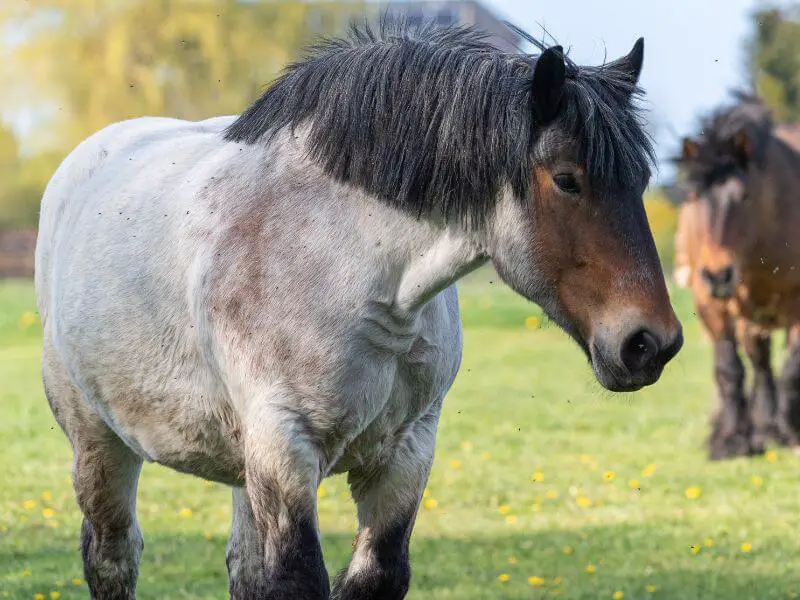
#10 Biggest Horse Breed: Ardennes
Origin: The Ardennes horse breed, one of the oldest draft breeds, originates from the Ardennes region spanning Belgium, France, and Luxembourg.
Physical Traits: Stand between 15 and 16 hands tall, weighing between 1,500 to 2,200 pounds. Broad, muscular stature, compact body, feathered fetlocks, and calm demeanor.
Use: Historically renowned as artillery horses, Ardennes are currently used for competitive driving, therapeutic riding, farm and draft work, and even meat production.
Health: Hardy and resilient, able to withstand harsh climates and rarely suffering from illnesses. However, prone to developing sidebone, a common hereditary condition that affects their hooves.
The Ardennes horse, also known as Ardennais, is one of the oldest horse breeds, originating from the Ardennes region in Belgium, Luxembourg, and France.
These horses are believed to descend from the Solutrean horse, an ancient breed from the Paleolithic era (around 50,000 BC).
Historical records, including those from Julius Caesar, show the Ardennes praised for its strength and endurance.
Over the centuries, these horses have evolved from 14 hands high in the Roman era to between 15 and 16 hands high today. This size increase was thanks to selective breeding and a blend of Belgian draft blood in the 19th century. Now, these horses weigh between 1,500 to 2,200 pounds, making them a medium-sized draft breed.
Despite their muscular build, Ardennes horses are known for their calm and friendly nature.
They’re easy to train, making them a favorite among both kids and adults. Their strength and stamina have allowed them to serve in many roles, including as artillery horses during the French Revolution and as therapy horses for the Riding for the Disabled Association in the United Kingdom.
One health issue these horses often face is sidebone, a hereditary condition affecting their hooves. Studies show that 95% of Ardennes horses develop this condition, but it generally doesn’t harm their overall health.
Their looks are enhanced by feathering on their fetlocks, a common trait among draft horses. They come in several colors, including chestnut, bay, roan, gray, and palomino.
Black Ardennes horses are rare and not eligible for registration.
The Ardennes breed has contributed to the development of other breeds like the Baltic and Swedish Ardennes, and the Comtois breed. This shows their importance in the equine world.
#11 Biggest Horse Breed: Russian Heavy Draft
Size: 14.1 – 15 hands
Weight: 1,212 – 1,543 pounds
Lifespan: The average lifespan of a Russian Heavy Draft horse is typically around 25-31 years.
Uses: Originally bred for draft work in agriculture, the Russian Heavy Draft is now also kept for its high milk yield and meat. They have also been used in cross-breeding to improve other breeds.
The Russian Heavy Draft Horse, often called the Russkii Tyazhelovoz, is a unique horse breed from Russia, created in the 19th century.
They’re famous for their strong pulling power and speed, making them excellent working horses. They also don’t need too much food, making them cost-effective to keep.
In the beginning, people called them the Russian Ardennes, but since 1952, during the Soviet era, they’ve been known by their current name.
The breed’s genes come from Ukrainian horse breeds, the mountain Ardennes, and a bit from the Brabancon and Orlov Trotter breeds.
The development of this breed started around the 1860s. Important places in this process were the Petrovsky Agricultural and Forestry Academy in Moscow, Chesma and Dubrovsk stud farms in Voronezh region, Kochubei and Chaplits studs in Poltava region, and Derkulski stud in Ukraine, along with other famous stud farms.
They also brought in Ardennais stallions from Sweden, their numbers increasing from nine in 1875 to almost six hundred by 1915.
The Russian Heavy Draft Horse may be little, but he packs a mighty punch. They develop swiftly and have robust muscles, a thick mane of hair on their shoulders, and a sturdy neck.
Their tiny legs (about 22 centimeters in circumference) and very light heads set them apart. Colors including chestnut, strawberry roan, and bay are common.
These horses are well-known for their boundless enthusiasm and versatility. North Caucasus, Ukraine, Sverdlovsk, Perm, Vologda, Archangel areas, western Siberia, Udmurtia, and Kirov, Byelorussia are all sites where they are bred.
These horses were originally intended for agricultural labor, but are currently primarily kept for their milk production, which is substantial (about 2500 kg in six or seven months).
Milk is commonly used to make kumis, a fermented beverage that is believed to improve health and digestion.
The meat-eating reputation of the Russian Heavy Draft Horse is due in part to its role in the improvement of other breeds, such as the Bashkir.
World War I and the Russian Revolution reduced their numbers, but by 1937 they had recovered. They made it through the difficulties of the twentieth century to become a robust population.
Nearly 50,000 of these horses existed in the 1980s.
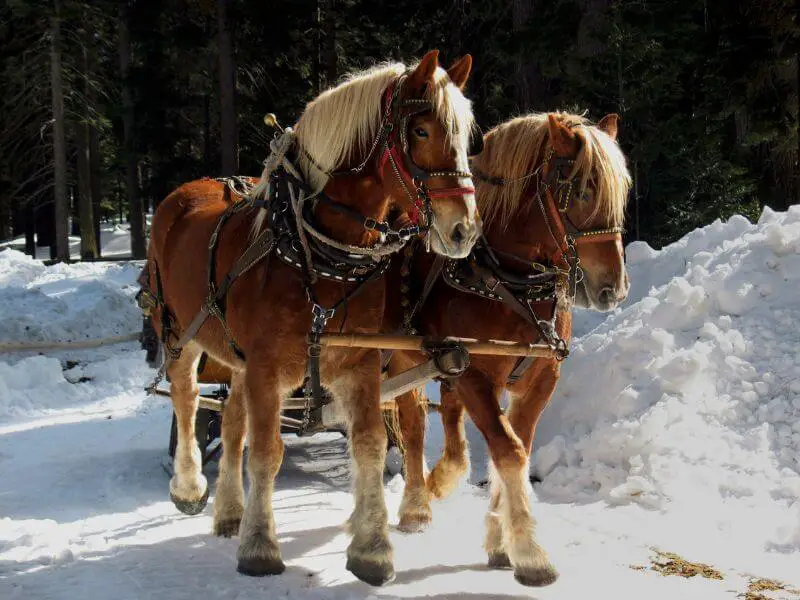
Common Traits Among the World’s Largest Horses
Each horse is different and has its own personality and characteristics. But horses from the same type, frequently have similar appearances and behaviors.
This is especially true for large horses or draft horses, many of which have exceptional power, large stature, and a strong work ethic in common.
Draft horse breeds are distinguished by enormous size and strength. They have big, musculated bodies and feet. Because they are composed and effective workers, they are frequently referred to as “gentle giants”.
The largest horse breeds typically exhibit the following characteristics:
Great strength: These horses were often used for farm work, so they are very muscular and can pull heavy things easily.
Calm personality: Even though they are big and strong, these horses are gentle, making them good work partners for people.
Muscular body: Big horses usually have muscles that are easy to see, which helps them be strong and have lots of stamina.
Calm and patient: These horses are not only gentle, but also calm and patient. This makes them easy to train and take care of.
Where they come from: The biggest horses mostly come from Europe. People used to use them for farm work, transportation, and even in the military.
High energy: These horses may be calm, but they also have lots of energy. They need regular exercise and training to stay happy and healthy.
Strong work ethic: Because they were bred for work, big horses often have a strong desire to do a good job and make their handlers happy.
Versatile: Even though they were originally bred for things like farm work, big horses can do a lot of different things, including riding, driving, and even jumping.
Long life: On average, big horses live longer than smaller breeds. Many live into their late twenties.
Draft horses, commonly known as ‘cold bloods’ due to their calm disposition, share similarities but also distinct distinctions in body shape, coat colors, and personalities.
The majority of these ‘cold bloods’ are from chilly European locations and have fuzzy feet, sometimes known as feathers. These give warmth but must be carefully cared for to avoid skin concerns.
While “draft” is not a breed in and of itself, horses in this group are frequently calm and kind. They are well-known for their forgiveness, alertness, and common sense.
Despite the fact that every horse is different, draft breeds are normally pleasant, laid-back, eager to work when asked, and like to please their owners.
Even among these massive horses, there are subtle variances in temperament. Percherons, for example, are typically more lively, but Clydesdales are calmer than Belgians but still more energetic when compared to lesser breeds.
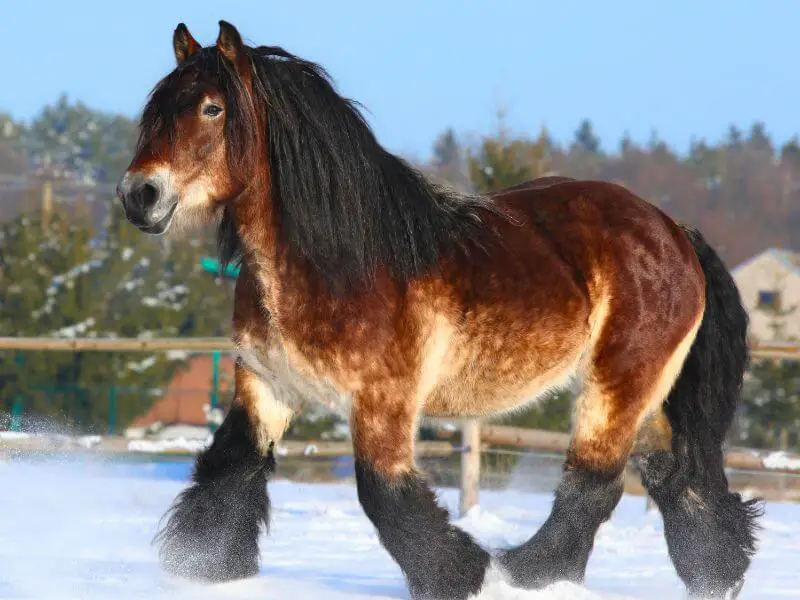
Summary Chart Of The Largest Horse Breeds
Here is an easy to scan table on stats for the biggest horse breeds.
| Horse Breed | Average Height (hands) | Average Height (inches) | Average Weight (pounds) |
|---|---|---|---|
| Shire | 16 – 17.2 | 64 – 68 | 1870 – 2430 |
| Belgian | 16 – 17 | 64- 67 | 1800- 2200 |
| Clydesdale | 16 – 18 | 64 – 72 | 1800 – 2000 |
| Percheron | 16.2 – 17.3 | 64.8 – 69.2 | 1800 – 2200 |
| Suffolk Punch | 16.1 – 17.2 | 64.4 – 68.8 | 1600 – 2000 |
| Australian Draft | 16.2 – 17.2 | 64.8 – 68.8 | 1300 – 1900 |
| Dutch Draft | 15 – 17 | 60 – 68 | 1550 – 1650 |
| American Cream | 15.1 – 16.3 | 60.4 – 65.2 | 1600 – 1800 |
| Boulonnais | 15.1 – 17 | 60.4 – 68 | 1430 – 1650 |
| Ardennes | 15 – 16 | 60 – 64 | 1800 – 2200 |
| Russian Heavy Draft | 14.1 – 15 hands | 57 – 60 | 1,200 – 1,550 |
So now you know a little bit about the biggest horse breeds in history.
You’ve checked out their unique stories and found out what makes them stand out from other types of horse breeds.
These giants are so impressive with their strength and massive size!
Now you can appreciate them that much more when you come in contact with a draft horse.
If you’re eager to learn more about horses, make sure to check out our other related blog posts.
Cheers, Kacey
P.S. Did you like this article? Gallop over to:

